Pay attention. This could save your life.
In this article, I'm going to show you exactly how I put together our gun range trauma kit so you can do the same.
Notice I said trauma kit. I'm not talking about a boo-boo Band-Aid® kit. I'm talking about a kit that can be used to stop massive blood loss to save your life.
There's no denying we do everything possible to avoid injuries, especially gunshot wounds, but we'd be negligent if we weren't prepared just in case. I mean, you probably don't plan on getting into a car crash but I bet you've got insurance just in case. Right?
The Bag
The color red is universally associated with first-aid so it only made sense to go with a red bag. I quickly discovered there's a lot of red bags out there.
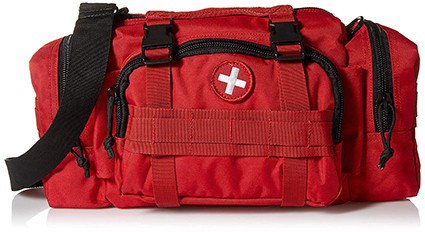
After doing pretty extensive research into the various sizes and materials, I decided to go with the Condor Deployment Bag. It's not too big. It's not too small. And it has multiple pockets to keep everything organized.
Tourniquet
A good, quality tourniquet is an absolute necessity for every trauma kit. No exceptions.
Nothing works better at stopping the gushing blood coming from a severed artery (or vein) than a properly applied tourniquet. The only downside is it can only be applied to limbs. A traumatic wound anywhere else requires a different solution (keep reading).
The two big players in this arena are North American Rescue and Tactical Medical Solutions.
I've been fortunate enough to play with both North American Rescue's Combat Application Tourniquet (C-A-T) and Tactical Medical Solutions's SOF® Tactical Tourniquet (SOFTT), and the wide variation (SOFTT-W).
For a couple different reasons I prefer the C-A-T over both the SOFTT and the SOFTT-W.
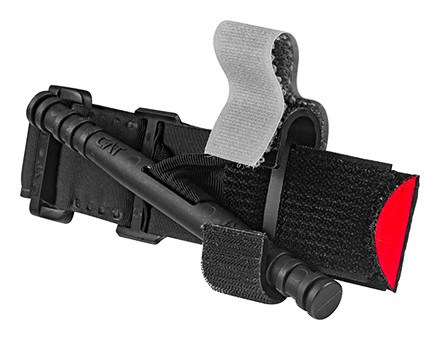
For starters, I've found the C-A-T to be significantly faster and easier to apply, especially one-handed. Once a major artery is severed you've only got about 30-45 seconds of usable consciousness to get the bleeding under control. I think it's pretty obvious here that time is of the essence.
A significant disadvantage of the SOFTT is the design doesn't allow them to work well on infants and small children. I don't know about you but I want a tourniquet that is going to work no matter what situation I find myself in.
A word of caution. These tourniquets, especially the C-A-T, are very commonly counterfeited. Do not, I repeat, DO NOT buy them anywhere other than from the manufacturer (linked above).
The last thing you want to happen when your life depends on it is to have a cheap knock-off that fails to do its job.
Combat Gauze®
All right. As previously stated a tourniquet is limited to wounds to the extremities. So what can you do if the wound is to another part of the body?
Enter Combat Gauze® by QuikClot®.
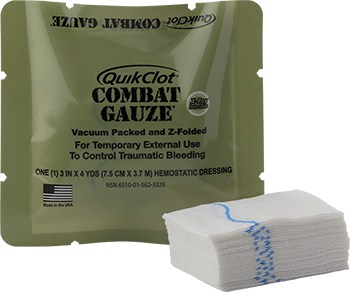
Combat Gauze® is impregnated with an inorganic mineral called kaolin. Kaolin accelerates the body's natural clotting ability which ultimately results in the bleeding stopping or slowing significantly faster than with standard gauze.
Its use is recommended by the Committee on Tactical Combat Casualty Care (CoTCCC) for all 5 branches of the US military. Quite frankly, if it's good enough for soldiers in battle it's good enough for us on the gun range.
Chest Seals
If the chest wall becomes perforated (e.g. a bullet hole that's not supposed to be there) one or both lungs may collapse (pneumothorax) due to air entering the space between the lungs and the chest wall, instead of into the lungs where it belongs. You may hear this referred to as a sucking chest wound due to the hissing or sucking sound made as air enters or exits the hole while breathing.
NOTE: Sometimes sucking chest wounds make no noise, so it's better to play it safe than sorry and treat any chest penetration as a sucking chest wound.
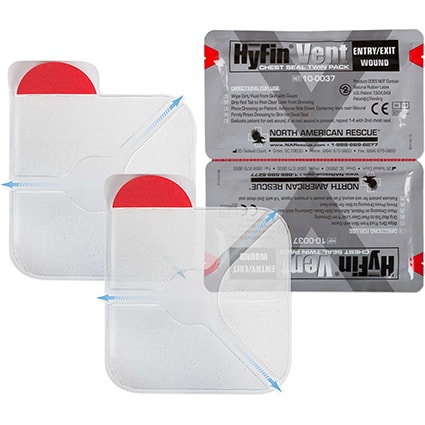
Pre-hospital, first-aid treatment of a sucking chest wound is relatively simple. The priority here is sealing the hole(s) so proper breathing can be reestablished quickly. This can be accomplished either by placing a piece of plastic (sterile preferably) over the hole and taping it down or, better yet, by applying a commercial chest seal designed for this exact purpose.
There are multiple types of chest seals available, and any of them should work, but I went with the Hyfin® Vent. It's reasonably priced, easy to apply, and comes in a twin-pack (two is better than one in case there are both entry and exit wounds).
CPR Mask
Every first-aid bag should include a quality CPR mask.
Giving CPR to someone without a barrier device is a significant health risk for you. The most important part of a proper barrier is the one-way valve. This valve allows air to pass from the person giving aid to the person requiring aid, but not vice-versa.
This means if the person vomits, which is pretty common, it will not pass through the valve...into your mouth. They are cheap enough there's really no reason to risk it.
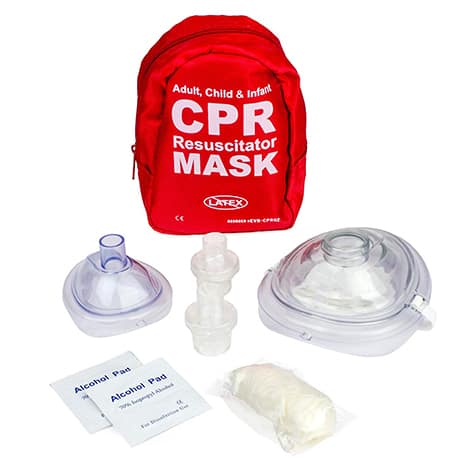
I don't know about you, but if I don't know what kind of funk someone has I'm not giving mouth-to-mouth without a mask. The good news is that some of the recent research indicates that compressions, rather than breaths, may be the most important CPR component. So you're not totally helpless without a mask. Begin doing compressions until someone can bring a mask or until EMS arrives.
Miscellaneous First-Aid Supplies
I also included a variety of "regular" first-aid supplies for the less severe injuries: things like disposable gloves (latex-free), traditional elastic wrap bandages, pressure bandages, gauze, surgical tape, trauma shears, and flexible fabric bandages (Band-Aid®). You can buy these from your favorite pharmacy or big box store, both local and online.
Feel free to add anything else you feel is necessary!
What's Your Life Worth?
The importance of having a well-stocked trauma kit cannot be overstated.
While a proper trauma kit will set you back a couple hundred dollars, or maybe more depending on how many of each item you buy, I think you'll agree your life is priceless – Certainly worth more than two or three hundred dollars.
So next time you go to the shooting range be sure to pack your trauma kit right next to all of your other range gear.